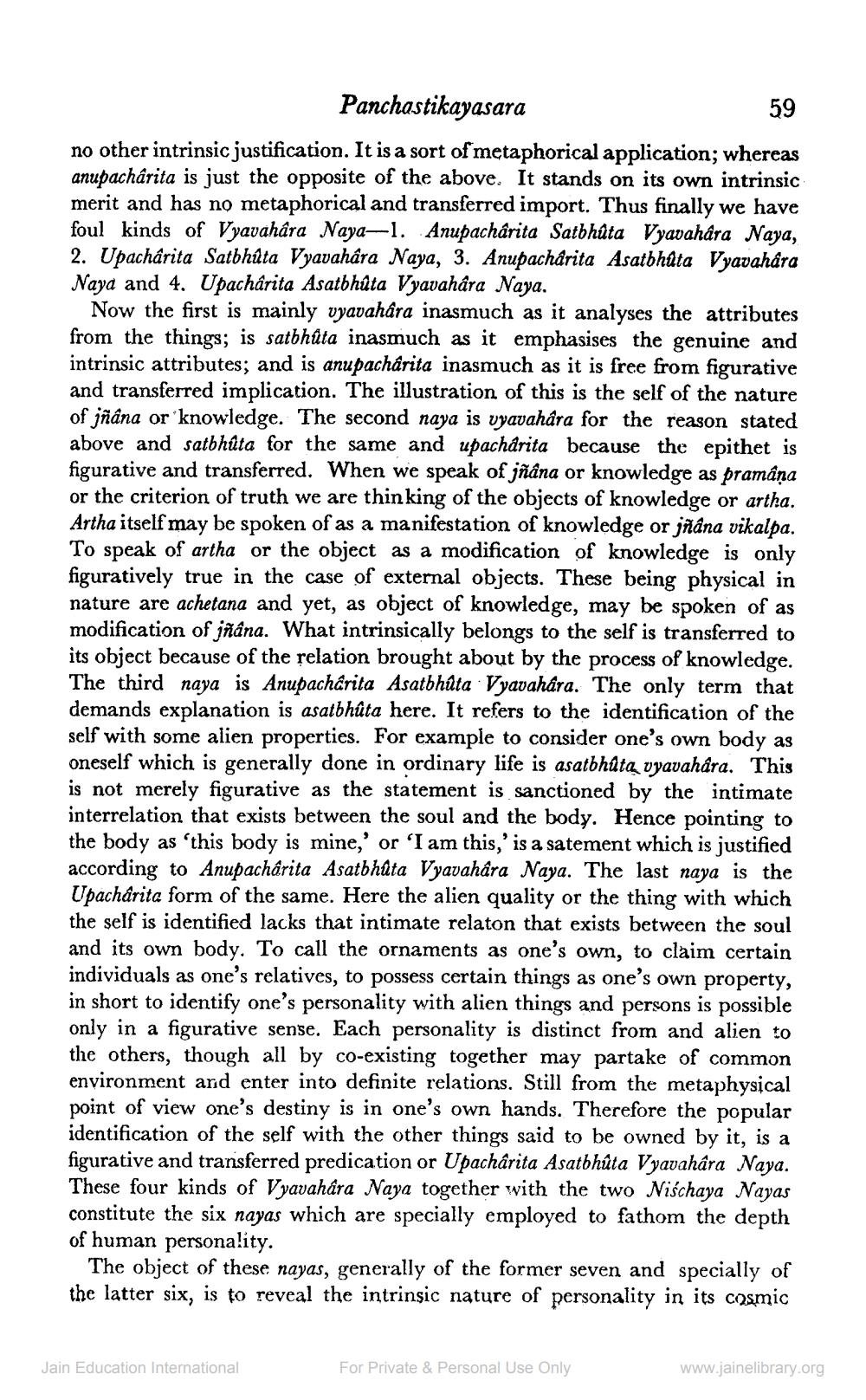________________
Panchastikayasara
59
no other intrinsic justification. It is a sort of metaphorical application; whereas anupachârita is just the opposite of the above. It stands on its own intrinsic merit and has no metaphorical and transferred import. Thus finally we have foul kinds of Vyavahára Naya-1. Anupachârita Satbhûta Vyavahara Naya, 2. Upachárita Satbhûta Vyavahára Naya, 3. Anupacharita Asatbhûta Vyavahara Naya and 4. Upachârita Asatbhûta Vyavahara Naya.
Now the first is mainly vyavahâra inasmuch as it analyses the attributes from the things; is satbhûta inasmuch as it emphasises the genuine and intrinsic attributes; and is anupachârita inasmuch as it is free from figurative and transferred implication. The illustration of this is the self of the nature of jñâna or knowledge. The second naya is vyavahara for the reason stated above and satbhûta for the same and upacharita because the epithet is figurative and transferred. When we speak of jñâna or knowledge as pramâna or the criterion of truth we are thinking of the objects of knowledge or artha. Artha itself may be spoken of as a manifestation of knowledge or jñâna vikalpa. To speak of artha or the object as a modification of knowledge is only figuratively true in the case of external objects. These being physical in nature are achetana and yet, as object of knowledge, may be spoken of as modification of jñana. What intrinsically belongs to the self is transferred to its object because of the relation brought about by the process of knowledge. The third naya is Anupacharita Asatbhûta Vyavahara. The only term that demands explanation is asatbhûta here. It refers to the identification of the self with some alien properties. For example to consider one's own body as oneself which is generally done in ordinary life is asatbhûta vyavahara. This is not merely figurative as the statement is sanctioned by the intimate interrelation that exists between the soul and the body. Hence pointing to the body as 'this body is mine,' or 'I am this,' is a satement which is justified according to Anupachârita Asatbhûta Vyavahâra Naya. The last naya is the Upacharita form of the same. Here the alien quality or the thing with which the self is identified lacks that intimate relaton that exists between the soul and its own body. To call the ornaments as one's own, to claim certain individuals as one's relatives, to possess certain things as one's own property, in short to identify one's personality with alien things and persons is possible only in a figurative sense. Each personality is distinct from and alien to the others, though all by co-existing together may partake of common environment and enter into definite relations. Still from the metaphysical point of view one's destiny is in one's own hands. Therefore the popular identification of the self with the other things said to be owned by it, is a figurative and transferred predication or Upachârita Asatbhûta Vyavahara Naya. These four kinds of Vyavahára Naya together with the two Nischaya Nayas constitute the six nayas which are specially employed to fathom the depth of human personality.
The object of these nayas, generally of the former seven and specially of the latter six, is to reveal the intrinsic nature of personality in its cosmic
Jain Education International
For Private & Personal Use Only
www.jainelibrary.org




